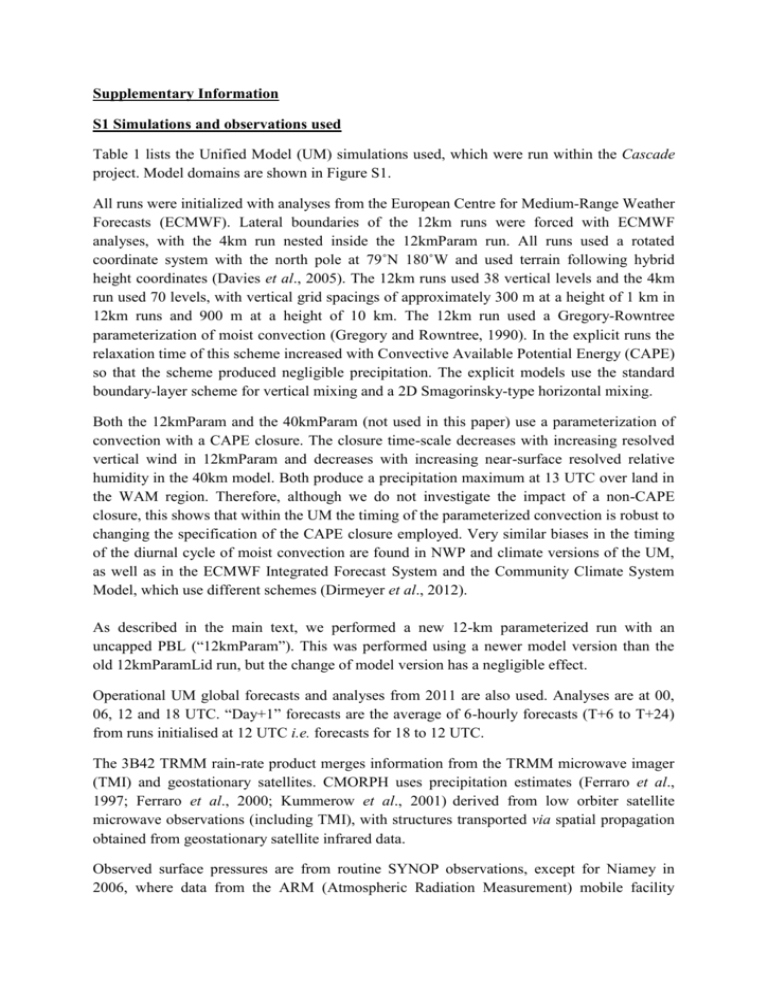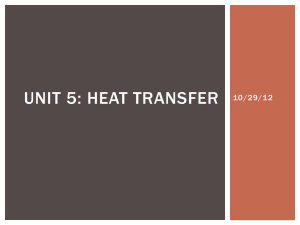grl50347-sup-0006-Marsham_supp_GRL_revised2_v1
advertisement

Supplementary Information S1 Simulations and observations used Table 1 lists the Unified Model (UM) simulations used, which were run within the Cascade project. Model domains are shown in Figure S1. All runs were initialized with analyses from the European Centre for Medium-Range Weather Forecasts (ECMWF). Lateral boundaries of the 12km runs were forced with ECMWF analyses, with the 4km run nested inside the 12kmParam run. All runs used a rotated coordinate system with the north pole at 79˚N 180˚W and used terrain following hybrid height coordinates (Davies et al., 2005). The 12km runs used 38 vertical levels and the 4km run used 70 levels, with vertical grid spacings of approximately 300 m at a height of 1 km in 12km runs and 900 m at a height of 10 km. The 12km run used a Gregory-Rowntree parameterization of moist convection (Gregory and Rowntree, 1990). In the explicit runs the relaxation time of this scheme increased with Convective Available Potential Energy (CAPE) so that the scheme produced negligible precipitation. The explicit models use the standard boundary-layer scheme for vertical mixing and a 2D Smagorinsky-type horizontal mixing. Both the 12kmParam and the 40kmParam (not used in this paper) use a parameterization of convection with a CAPE closure. The closure time-scale decreases with increasing resolved vertical wind in 12kmParam and decreases with increasing near-surface resolved relative humidity in the 40km model. Both produce a precipitation maximum at 13 UTC over land in the WAM region. Therefore, although we do not investigate the impact of a non-CAPE closure, this shows that within the UM the timing of the parameterized convection is robust to changing the specification of the CAPE closure employed. Very similar biases in the timing of the diurnal cycle of moist convection are found in NWP and climate versions of the UM, as well as in the ECMWF Integrated Forecast System and the Community Climate System Model, which use different schemes (Dirmeyer et al., 2012). As described in the main text, we performed a new 12-km parameterized run with an uncapped PBL (“12kmParam”). This was performed using a newer model version than the old 12kmParamLid run, but the change of model version has a negligible effect. Operational UM global forecasts and analyses from 2011 are also used. Analyses are at 00, 06, 12 and 18 UTC. “Day+1” forecasts are the average of 6-hourly forecasts (T+6 to T+24) from runs initialised at 12 UTC i.e. forecasts for 18 to 12 UTC. The 3B42 TRMM rain-rate product merges information from the TRMM microwave imager (TMI) and geostationary satellites. CMORPH uses precipitation estimates (Ferraro et al., 1997; Ferraro et al., 2000; Kummerow et al., 2001) derived from low orbiter satellite microwave observations (including TMI), with structures transported via spatial propagation obtained from geostationary satellite infrared data. Observed surface pressures are from routine SYNOP observations, except for Niamey in 2006, where data from the ARM (Atmospheric Radiation Measurement) mobile facility deployed during the AMMA (African Monsoon Multidisciplinary Analysis) field campaign were used due to their better temporal coverage. S2 Time evolution of model differences Figure S2 shows the time-evolution of the difference in the 950-hPa surface between the 12kmExp and 12kmParam runs. The main differences, which are over the Sahel, evolve quickly (in one day) as a result of differences in the treatment in moist convection. More slowly-evolving differences are observed over the northern Sahara, where ventilation from Atlas cold pools cools (Emmel et al., 2010) occurs in the explicit run. S3 Effects on the African Easterly Jet Figure S5 shows a northward shift in the African Easterly Jet (AEJ) in 12kmExp compared with 12kmParam, consistent with Figure 1e. The increased convection in the Sahel in 12kmExp increases the potential vorticity there that defines the southern side of the AEJ, giving an AEJ located more to the north. The explicit convection gives a lower geopotential at 700 hPa centered on 12 to 13°N (Figure 1e). This enhances the 12kmExp AEJ to the north (16°N) and weakens it to the south (8°S; Figure S5). S4 Further analysis of the diurnal cycle Figure S6 shows in more detail how the diurnal cycle in the pressure gradient and meridional wind are related in each run. The 3-hour lag applied to the winds in Figure S6 gives almost straight lines for the nocturnal winds (18 to 03 UTC), compared with the ellipse in Figure 2c. During the day, dry convection inhibits the monsoon flow, resulting in points located below the straight-line. The day-time dry convection occurs before the minimum pressure gradient at 18 UTC in 12kmExp, but during the 12 UTC minimum in 12kmParam. On average there is an “explicit-low” at low-levels over the Sahel (Figures 1d and 1e), but this has a significant diurnal cycle: Figure S7 shows the diurnal cycle in the difference in the mean cross-sections of 12kmExp and 12kmParam. At 06 UTC there is little difference between the runs: there is a weak “explicit-low” over the Sahel (dashed lines). The parameterized convection is active from 12 to 15 UTC and this builds the low-level parameterized-low over the Sahel, which is largest at 15 UTC. By 18 UTC the explicit convection is active (Figure 1a) and there is a weak explicit-low in the Sahel. With the continuing explicit convection this explicit-low continues to grow to a maximum at around 21 to 00 UTC. After this, as the convection continues to decline in 12kmExp, the differences between the runs decreases to reach a minimum at around 06 to 09 UTC. Figure S8 shows cross-sections of the mean diurnal cycle in each model. Both models show boundary-layer warming reaching 850 hPa at 15°N and 700 hPa at 25°N at 15 UTC. This deepens to 500 hPa at 25°N at 18 UTC in both models. This similar behavior is reassuring, as both models have the same boundary-layer scheme. Differences do arise from the differences in moist convection. At 12 UTC 12kmParam shows a warm diurnal anomaly centered on 600 hPa, around 10°N, from the parameterized convection. This grows as the parameterized convection continues, and at 15 UTC is centered at 16°N, 500 hPa (Figure S7 shows that at this time 12kmParam is warmer than 12kmExplicit at 500 hPa, and the runs are similar at 300 hPa, with a parameterized low below 600 hPa at 15 UTC). Figure S8 shows large diurnal anomalies in 12kmExp from moist convection between 18 and 21 UTC and by 18 UTC explicit convection has started to reverse the difference between the two runs (Figure S7). S5 Further analysis of UM forecast errors Figure S10 shows that the UM forecasts are too warm at mid-levels compared with analyses at 18 UTC and too cold at 00 UTC. This is consistent with the convection and resultant midlevel warming in 12kmParam occurring approximately six hours too early in the diurnal cycle, further supporting the hypothesis that errors from parameterized convection make a significant contribution to UM forecast biases. S6 Comparison with Observed Winds Figure 2e compares the Cascade runs with surface pressures from Niamey (13.5°N 2.1°E) and Tamanrasset (22.8°N 5.5°E). Figure S11 shows the corresponding meridional winds with radiosonde data. Winds, especially at low levels, are likely subject to more local effects than pressure, particularly at Tamanrasset, due to its mountainous location (which leads to an offset in the lowest UM grid-box height and the lowest observation height). At Niamey, below 2km, 12kmExp tends to give winds closer to observations than 12kmParam, except at 18 UTC. Above 2km it is unclear whether 12kmParam or 12kmExp is closer to the observations. At Tamanrasset, below 2km 12kmParam is closer to observations at 06 UTC, 12km Exp at 12 and 18 UTC, and they are similar at 00 UTC (when the height offset is accounted for). Above 2km it is unclear. The radiosonde winds therefore weakly support the hypothesis that the 12kmExp gives an improved representation of low-level winds and pressure gradients. Additional References Davies, T., M.J.P. Cullen, A.J. Malcolm, M.H. Mawson, A. Stainforth, A.A. White and N. Wood (2005), A new dynamical core for the Met Office’s global and regional modelling of the atmosphere, Q. J. R. Meteorol. Soc., 131, 1759-1782. Ferraro, R. R. (1997), SSM/I derived global rainfall estimates for climatological applications. J. Geophys. Res., 102, 16715-16735. Ferraro, R.R., F. Weng, N.C. Grody and L. Zhao (2000), Precipitation characteristics over land from the NOAA-15 AMSU sensor, Geophys. Res. Lett., 27, 2669-2672. Gregory, D. and P.R. Rowntree (1990), A mass flux convection scheme with representation of cloud ensemble characteristics and stability-dependent closure. Mon. Wea. Rev., 118, 1483-1506. Kummerow, C. et al.(2001), Evolution of the Goddard profiling algorithm (GPROF) for rainfall estimation from passive microwave sensors. J. Appl. Meteor., 40, 1801-1820. Horizontal Grid-Spacing 4 km 12 km 12 km Explicit convection Y Y Parameterized convection Y Vertical levels 70 38 38 Model version v7.1 v7.1 v7.3 Referred to as: 4kmExp 12kmExp 12kmParam Table S1. Unified Model (UM) simulations used in this study, performed in the framework of the Cascade project. Figure S1. Domains of the 12-km and 4-km Cascade simulations. Figure S2. Eleven-day accumulated rainfall (mm) in (a) 4kmExp, (b) 12kmExp, (c) 12kmParam and (c) from TRMM retrievals. Figure S3. Time-latitude Hovmöller of 12kmExp – 12kmParam differences in 950-hPa geopotential height (m) evolving through the simulation period (25 July to 4 August, 2006). Figure S4. Mean difference in the 950-hPa geopotential height for 12kmExp - 4kmExp (m). Areas where orography intersects the 950-hPa surface, or which are outside of the 4 km domain, are masked grey. Figure S5. 12kmExp-12kmParam zonal wind at 700 hPa (ms-1) showing the AEJ shifted south in 12kmParam. Figure S6. As Figure 2c, but with a 3-hour phase lag applied to the winds, moving nocturnal points towards a straight line. Figure S7. Cross-sections of 12kmExp-12kmParam differences in geopotential height (lines, 2-m spacing, dashed are negative), potential temperature (colors in K) and meridional wind at (a) 00, (b) 03, (c) 06, (d) 09, (e) 12, (f) 15, (g) 18 and (h) 21 UTC. Figure S8. As Figure S6, except showing diurnal anomalies from the mean in each run, with the left column (a, c, e, g and i) showing 12kmExp and the right column (b, d, f, h and j) 12kmParam, at (a, b) 12, (c, d)15, (e, f) 18, (g, h) 21 and (i, j) 00 UTC. Figure S9. Global UM forecast biases in 925-hPa geopotential heights (colored) and winds for July 2011, with (a) day+1 forecast – analysis, (b) day+2 forecast – analysis. Figure S10. July 2011 biases in potential temperature (colored) and winds (north-south and vertical) at (a) 00 UTC and (b) 18 UTC. Biases are means of day+1 to day+3, with biases detrended to remove the lead-time bias and leave the diurnal bias. Figure S11. Meridional wind profiles at Niamey (left) and Tamanrasset (right) at 00, 06, 12 and 18 UTC for 12kmExp (red), 12kmParam (black), 4kmExp (green) and radiosondes (blue). The standard error in the radiosondes from each level is shown in grey.






